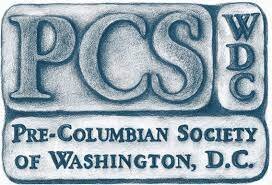Tlaloc, Sotuknangu, and the Origins of the Gods in Ancient Americ: The Case of Barrier Canyon Rock Art by by James Farmer, PhD, Virginia Commonwealth University.
This meeting will be held at the Charles Sumner School, 17th & M Streets, N.W., Washington, D.C.
The meeting starts with refreshments at 6:45 pm and the lecture begins at 7:15 pm
Rock art imagery constitutes one of the oldest and most widespread forms of artistic expression in human history, including the Ancient Americas. Yet Precolumbian art historical scholarship has routinely marginalized or separated critical consideration of rock art from so-called mainstream art historical analysis. In 1971, Polly Schaafsma defined the Barrier Canyon Anthropomorphic Style (aka. BCS) of painted or pictographic rock art images as one of the more significant styles of early Ancient American painting, centered in the modern American Southwest. Schaafsma based her initial study on only 19 documented BCS style sites, but in 1992, the BCS Project was initiated to locate and record additional BCS style rock art sites throughout the region. As of 2016, over 400 additional BCS sites have been recorded. This vastly expanded catalog of images now permits more critically focused analysis of the BCS style, including understanding the creation of early rock art imagery within a broader context of early Mesoamerican and Ancient Puebloan ideologies. Through the presentation of a number of related BCS compositions, and in consideration of historic Puebloan ethnographic sources, I argue that early, painted BCS rock art imagery presents the iconographic origins of a complex of gods and beliefs associated with later Puebloan creator gods (Hopi Sotuknangu) and Mesoamerican rain god equivalents (Aztec Tlaloc).
James Farmer joined the department of anthropology faculty at Virginia Commonwealth University in 1992. His general areas of specialization include Precolumbian and North American Indian art, with secondary interests in modern and contemporary Native and Latin American art. His specific research interests are divided between the ancient Archaic and Puebloan traditions of the American Southwest and the middle Formative and Late Horizon traditions of Ecuador and Peru. He has participated in archeological excavations in Colorado and Ecuador, and has conducted study abroad classes in Mexico, Guatemala, Honduras, Peru and the Southwest. He has chaired numerous conference sessions at the College Art Association and Southeastern College Art Conferences, and presented numerous papers and lectures nationwide and in Latin America on a variety of Precolumbian-related topics. He has served as a guest curator, collection consultant and exhibition catalog contributor to several major museums, including the Virginia Museum of Fine Arts, the Chrysler Museum, the Dallas Museum of Art, the Chicago Art Institute, and the Los Angeles County Museum of Art.
Dr. Farmer’s publications span a wide range of issues and subjects related to ancient American art and architecture, such as astronomy and women’s rituals in ancient Puebloan architectural design, symbolism in Maya textiles, early painting in rock art from the American Southwest, and early Andean ceramics and sculpture in highland Ecuador. His most recent publication is a co-authored book just released by University of Texas Press entitled Art and Archaeology of Challuabamba, Ecuador. ”My approach to Precolumbian art history stresses both the deep antiquity of technically complex and artistically sophisticated ancient American styles, as well as the nature of long range influence and interaction between the major traditions and styles”. He holds a BFA in studio art and a PhD in Art History from the University of Texas at Austin.
